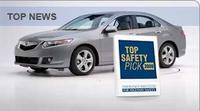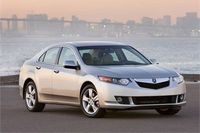2009 Acura TSX Is IIHS Luxury Car Top Safety Pick
ARLINGTON, Va., June 23, 2008; The redesigned 2009 Acura TSX, a midsize luxury car, wins the Insurance Institute for Highway Safety's TOP SAFETY PICK award. Winners afford superior overall crash protection among the vehicles in their classes. To qualify, a vehicle must earn the highest rating of good in the Institute's front, side, and rear tests and be equipped with electronic stability control. The new TSX improved in the side test from acceptable to good and in the rear test from poor to good, compared with the previous model.
"Criteria to win are tough because TOP SAFETY PICK is intended to drive continued improvements such as top crash test ratings and rapid addition of electronic stability control, which is standard equipment on the TSX," says Institute president Adrian Lund. "Recognizing vehicles at the head of the class for safety helps consumers distinguish the best overall choices without having to sort through multiple test results."
"This is the third Acura and the eighth model from Honda to earn our top award," Lund says. "Frontal crashworthiness has improved dramatically for all cars in recent years, but there still are significant differences in how vehicles perform in our side and rear tests."
Huge improvements in protection for people in rear crashes: Seat/head restraints in the 2004-08 TSX were rated poor for occupant protection in rear crashes. Honda redesigned the seats in the 2009 TSX to earn a better rating, and when the Institute tested the new seat, it earned the highest rating of good.
"You don't know what kind of crash you're going to be in," Lund says, "so it's important to choose a vehicle that will protect you in all kinds of crashes."
In 2007 the Institute made the criteria to earn TOP SAFETY PICK tougher by adding a requirement -- winners must be equipped with electronic stability control (ESC). Known by different names and called vehicle stability assist on the TSX, ESC helps drivers maintain control in the worst situation -- loss of control at high speed -- by engaging automatically when it senses vehicle instability and helping to bring a vehicle back in the intended line of travel. ESC lowers the risk of a fatal single-vehicle crash by about half. It lowers the risk of a fatal rollover crash by as much as 80 percent.
How vehicles are evaluated: The Institute's frontal crashworthiness evaluations are based on results of 40 mph frontal offset crash tests. Each vehicle's overall evaluation is based on measurements of intrusion into the occupant compartment, injury measures recorded on a Hybrid III dummy in the driver seat, and analysis of slow-motion film to assess how well the restraint system controlled dummy movement during the test.
Side evaluations are based on performance in a crash test in which the side of a vehicle is struck by a barrier moving at 31 mph. The barrier represents the front end of a pickup or SUV. Ratings reflect injury measures recorded on two instrumented SID-IIs dummies, assessment of head protection countermeasures, and the vehicle's structural performance during the impact.
Rear crash protection is rated according to a two-step procedure. Starting points for the ratings are measurements of head restraint geometry -- the height of a restraint and its horizontal distance behind the back of the head of an average-size man. Seat/head restraints with good or acceptable geometry are tested dynamically using a dummy that measures forces on the neck.




